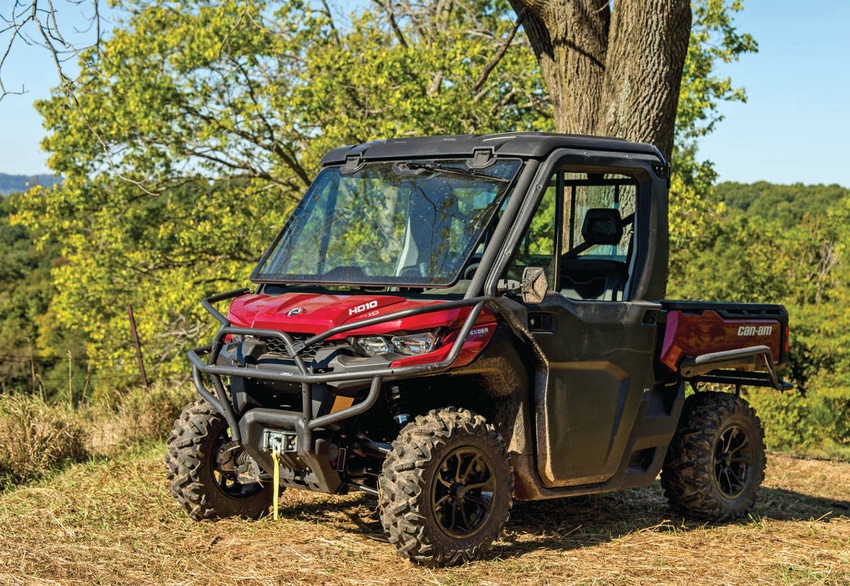
The people at Can-Am had a clear and simple goal in mind when they developed their new Defender side-by-side UTV.
“We needed something to go up against the Polaris Ranger,” says Matt Tandrup, Can-Am’s design and innovation manager. So Can-Am, long known in the performance and racing segments, set out to learn about utility customers.
“We talked to a lot of people, we went to their farms, we did a day-in-the-life with them,” Tandrup says. “We threw hay bales with farmers and tried to find out how they use their side-by-side, and we wanted to see if we could make a better one.”
The result is a machine that offers plenty of power and a host of handy features, and it looks good.
The Defender line offers two Rotax V-twin heavy-duty utility, rear-mounted engine options. The HD10 offers 72 hp at 976cc; the HD8 offers 50 hp at 800cc. The Pro-Torq transmission enhances low-speed riding with smoother power delivery and hill descent control offers smooth and predictable deceleration. The vehicle has a four-mode traction system and three selectable driving modes, which can be set depending on the situation and driver. The Defender also has a digitally-encoded security system with three programmable keys, all located under the hood so they can’t be easily changed. Work key limits to 25 mph; standard key limits to 44 mph and 10% torque reduction; performance key has no restriction.
The separated differential helps give the Defender a nice, tight turning radius, too, which is two feet shorter in a full circle than its closest competitor. Its dynamic power steering capabilities make those quick turns even easier and faster – think moving cows or negotiating creeks.
Taking care
Tandrup says among the top requirements they heard from farmers? Easy maintenance. The Defender is designed to be maintenance-free for one year – 1,865 miles or 200 hours. It has a fully-welded frame that makes it strong and easy to service and a high-rigidity chassis it to make it more automotive-like: no squeaking or rattling as you drive around.
The Can-Am folks also worked in a host of features and options that make the Defender both fun and useful to drive. The bumper has an integrated back step with a protective anti-corrosion coating. A body side protector keeps you from getting hung up on fence posts and keeps livestock away from the wheels. It’s built for long range with a 10.6-gallon fuel tank.
The Defender was designed to tow up to 2,000 pounds and carry up to 1,000 pounds, with a 56% rear and 44% front weight distribution. Tandrup says they designed the bed with recesses to corral 5-gallon buckets, and steel anchors for tie downs. Can-Am’s LinQ is a quarter-turn quick connect system, and there are 14 located on the top of the bed box. Notches let you divide the box in a variety of ways with plywood, and the tailgate offers 250-pound capacity. With a high-capacity bed, the Defender was designed with well-planned assist and dump points to make it easy. An electric power tilt option lets you fully lift in 20 seconds.
A bed wall extender option lets you triple the capacity of the box; top panels fold down and the rear door can be latched open or removed.
Up front options
In the front, there’s a 40/20/40 split bench seat for three adults, featuring heavy-duty vinyl and angled corners for easier entry and less wear. A foldable center console with armrest and cup holder comes on the XT model; look for four cup holders on most models. The flip-up seat offers a waterproof storage bucket underneath. You can also pull that out, leave the seat up and you have a completely flat floor space – ideal for taking your farm dog to the pasture. The dash features a removable waterproof toolbox, and visibility was maximized with pillars that are placed out of line of sight.
Roof options include a plastic sport roof and a bimini roof with sun visor. Three windshields are available: full, half, hardcoated full, plus a variety of rear window options. Four basic models are available, with virtually limitless options: the Defender, Defender DPS, Defender XT and Defender XT Cab.
The Defender HD8 lists for $10,999; Defender XT HD10 lists for $17,799; and the Defender XT Cab HD10 lists for $23,699.
For more information, visit can-am.brp.com/off-road.
My take - a rider's perspective
I liked the Can-Am Defender a lot. I’ve ridden the trails at Heartland Lodge before, operating another side-by-side vehicle and I really appreciated the features of the Defender on this trip. Can-Am’s new entry was an easy ride, nimble, powerful and I really welcomed the downhill breaking. The rear engine mount made it quiet and cool. Both engines offered plenty of power, and I can see it being used both on the farm for real work – check the cows, check the fence, haul the mineral – and for some fun times riding trails or hunting, too.
About the Author(s)
You May Also Like




